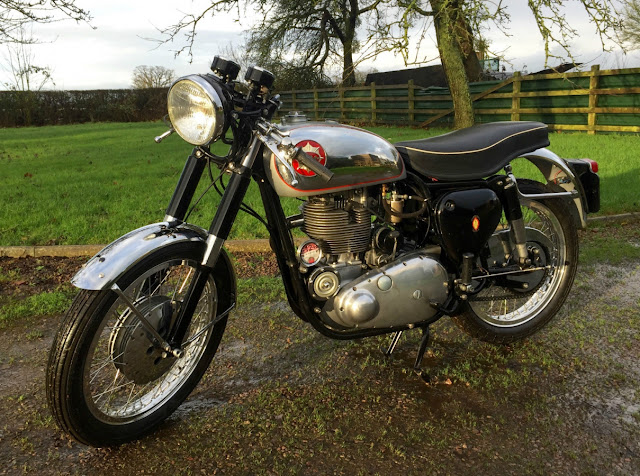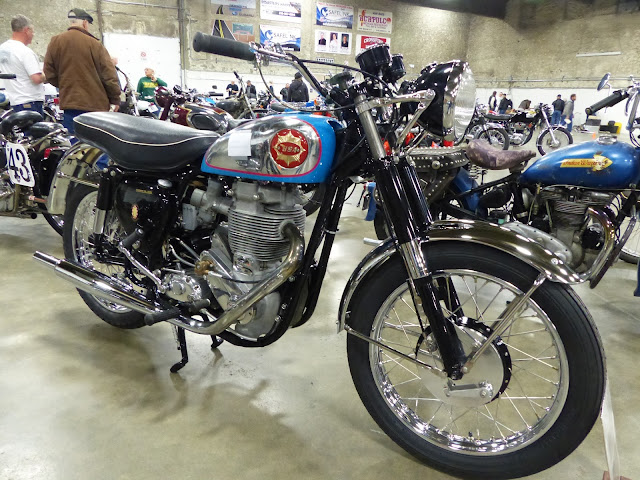BSA Gold Star Clubman
For a competition-hungry motorcyclist in the 1950s, a Gold Star DBD34 Clubman was arguably the ultimate machine, whether for racing on the Isle of Man, on short circuits or on the street in unofficial burn-ups between coffee bars. Lean, purposeful and unmistakably aggressive, the DBD34 Clubman was the last, fastest and best known version of a series of Gold Star singles that included 350 and 500cc bikes in touring, trials and scrambles form.
Unmistakable appearance
Its look was unmistakable: chrome-panelled fuel tank with BSA’s famous star-in-a-red-circle badge, headlight jutting up above a narrow pair of clip-ons, swept-back exhaust pipe leading from a heavily finned vertical cylinder. And the performance was unique, too. First gear was good for no less than 60mph (97km/h). With the rider’s chin brushing the big steering damper knob, the ‘Goldie’ had a genuine top speed of over llOmph (177km/h).
The Gold Star story began in 1937, when racer Wal Handley earned a Brooklands Gold Star award for lapping the banked Surrey track at over lOOrnph (161km/h) on BSA’s 500cc M23 Empire Star. In the following year BSA produced a replica marketed under the name M24 Gold Star, the name signifying that each machine had been built using selected components, tuned and dyno-tested. with polished ports, conrod and crankcases.
That first Gold Star also had magnesium gearbox casings and aluminium cylinder head and barrel. Power output was 28bhp when fuelled by petrol, or 33bhp when tuned to run on alcohol. Buyers received a certified dyno chart from their machine, a custom that was maintained with Gold Stars throughout. But BSA management decided
There were few more exciting bikes in the 1950s than a well-set-up Gold Star Clubman, which combined engine power with light, agile handling and powerful braking.
This 1956-model DBD34 Clubman has all its go-faster components present and correct, including low clip-on bars, rear set footrests, filterless Amal carburettor and free-breathing megaphone exhaust. Not to mention the free-revving engine whose 42bhp peak output gave a top speed of well over lOOrnph (161km/h).
That to reduce costs the sports Gold Star should resemble the standard single as much as possible, so its chassis was relatively standard.
After the Second World War, BSA produced a competition bike called the B32, based on its pushrod single the B31. This was initially made for use in trials, but when fitted with an aluminium cylinder head and barrel its racing potential was clear. For 1949 BSA introduced the 350cc ZB32 Gold Star, followed a year later by the 500cc ZB34. Both were rapid, competitively priced and came with various options - four camshafts, three different sets of gears (standard, scrambles and racing), four compression ratios (for use 'with different fuels), and choice of fuel tanks, exhaust systems and wheels.
Suddenly the clubman racer had a machine well suited to road and track. At the TT in 1949, Harold Clark averaged over 75mph (121km/h) on a ZB32 to win the Junior Clubman’s race, and in following years the Gold Star dominated both the 350cc Junior and 500cc Senior. In the 1955 Junior, no fewer than 33 of the 37 riders were on Goldies. But BSA's supremacy led to the Clubman’s TT being dropped after the following year.
Competition wins
In 1956 BSA introduced the DBD34, which benefited from a development programme that had seen factory aces including Bill Nicholson ride Goldies to many wins in scrambles and trials. Competition-proven modifications, including steeper steering geometry, swingarm rear suspension and a new front brake, had subsequently been fitted to the production machine. The DBD34 also incorporated engine updates introduced by BSA’s chief designer Bert Hopwood. It featured a big Antal GP carburettor, ultra-close-ratio gearbox and peak output of 42bhp at 7000rpm.
Other changes for the DBD34 Clubman's included the provision, for the first time, of the lights required by that season’s racing regulations. That gave the Gold Star a deceptively normal appearance, but there was no doubting its suitability for serious competition. This was a true racebike on the road: demanding, temperamental and - most of all - very fast indeed.
The Gold Star tank badge dated back to the Brooklands Gold Star award won by BSA rider Wal Handley.
Slim, uncluttered lines not only helped the BSA’s speed but made the bike look wonderfully purposeful too.
Specification BSA DBD34 Gold Star Clubman (1956)
Engine Air-cooled ohv two-valve pushrod single
Capacity 499cc (85 x 88mm)
Maximum power 42bhp @ 7000rpm
Transmission Four-speed, chain final drive
Frame Steel twin downtube
Suspension Telescopic front; twin shocks rear
Brakes Drum front and rear
Weight 384lb (174kg)
Top speed 110mph (177km/h)




















0 comments: